Saturday, February 27, 2021
5 EXCITING Oculus Quest 2 Updates You Should NOT Miss!
Oculus released so many new updates last week. Let's catch up together! I cover 5 big updates that came out for Oculus Quest 2 and 1, like a timeline for the 120hz refresh rate, PC VR streaming is now officially on the Quest store, Quest 2 Pro / 3 really coming? And more! ► Our VR equipment kit & tips here → https://www.amazon.com/shop/caschary (affiliate link) ► Subscribe here → https://goo.gl/bSJ6L8 This week has been crazy for the VR industry. We got so many updates and good news that I’m beyond excited. ----------------------------------------------------------------------------------- LINKS ► Virtual Desktop Tutorial → https://youtu.be/4YIvi7lgn_A ► Hyper Dash VR Gameplay → https://youtu.be/TBHtZ-4W8Pc ► Update VRiday #2 (VR News) → https://youtu.be/Q3FMeJ6p6pM ► Get an Oculus Quest 2 (US) → http://bit.ly/quest2-casvr ► Get an Oculus Quest 2 (NL - Coolblue) → https://cb.prf.hn/l/784dkp8 ► Get on Amazon → https://amzn.to/2RSxaDi May contain affiliate links that earn us a small referral fee from qualifying purchases at no extra cost to you. ----------------------------------------------------------------------------------- TIMESTAMPS 00:00 Intro (Watch full video for support!) 01:20 Virtual Desktop PC VR Streaming Now On Official Quest Store 02:54 Bring Your Couch To VR 04:03 120Hz Refresh Rate RELEASE DATE! 05:29 Weirdest Update 06:00 Is A Quest 2 PRO / 3 Coming? 07:29 Star Wars - The Mandalorian Game?! ----------------------------------------------------------------------------------- SUPPORT THE CONTENT (and become our VR Champion) ► Become our Patron → http://bit.ly/PatreonCasandChary ► Become a Sponsor on YouTube → http://bit.ly/JoinCasandChary ► Buy our VR Merch → http://bit.ly/casandchary-merch VR DISCOUNT CODES & AFFILIATE LINKS ► ► https://casandchary.com/discount-codes-affiliate-links/ ----------------------------------------------------------------------------------- OUR GEAR Our VR Equipment & Tips → https://www.amazon.com/shop/caschary (affiliate link) Our PC Specs → https://casandchary.com/vr-equipment/ MUSIC Music we use is from Epidemic Sounds → http://bit.ly/CCEpidemicSound ----------------------------------------------------------------------------------- GET LATEST UPDATES Twitter → https://twitter.com/CasandChary Facebook → https://www.facebook.com/casandchary/ Instagram → https://www.instagram.com/casandchary/ Join our Discord → https://discord.gg/YH52W2k ----------------------------------------------------------------------------------- A SPECIAL THANKS to these Patreon Champs 🛡️ for their support: 😘 BaxornVR, Wintceas, Studioform VR, Barr'd4Life, Andy, Albert, Ben P., Steve Dunlap, Thomas M. Rice, Andy Fidel, VR Balance, Nathan S., Adriaan K, Old Lady Gamer ----------------------------------------------------------------------------------- DISCLAIMER This video was not sponsored. Links in this description may contain affiliate links. We may earn a small referral fee from qualifying purchases that help supports the channel. However, it doesn't cost you more. #oculusquest2 #vr #casandchary VR on! - Cas and Chary VR
Friday, February 26, 2021
‘Virtual Desktop’ Can Now Stream PC VR Games to Quest, Without the Sideloading Workaround
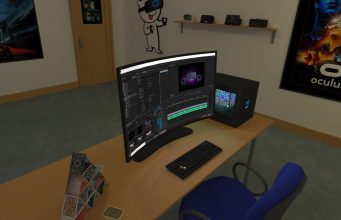
Virtual Desktop, an Oculus Quest app which allows users to control their Windows PCs from inside the headset, now officially offers the ability to stream PC VR games wirelessly to the headset. Facebook had previously not allowed the feature to be included with the app, restricting it to a complicated sideloading process.
Virtual Desktop—which is also available for PC VR headsets—is a long-running piece of virtual desktop software which allows users to access their Windows PCs from inside their VR headset. The Quest version launched on the headset back in 2019 and was later updated with a new feature which allowed users to stream PC VR content from Oculus PC and SteamVR to Quest—much like a wireless version of Oculus Link.
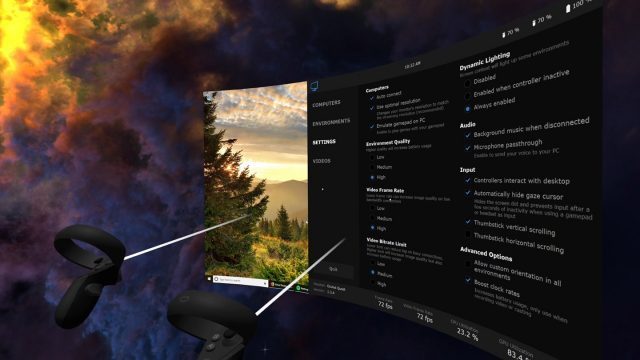
Shortly thereafter, Oculus forced the developer to remove the feature, saying it didn’t meet its quality guidelines. The developer made it possible to patch the app with the feature, but it required a complicated sideloading process which involved users posing as developers in order to get the necessary files onto their headset.
The controversial move stood for more than a year and a half—until today, when Oculus reversed course and allowed the full-featured version of Virtual Desktop, including PC VR streaming capabilities, onto the Quest store, UploadVR reports.
The move comes shortly after Oculus introduced App Lab, a long-awaited official avenue for developers to distribute apps on Quest while bypassing Oculus’ ‘curation’ process for the main Quest store.
At the time of App Lab’s introduction, it was thought that if Oculus wouldn’t allow the Pc VR streaming feature of Virtual Desktop onto the main Quest store, it should at least allow it an App Lab version since the capability didn’t explicitly violate any of Oculus’ technical guidelines. In a surprise move, Oculus actually wound up allowing the full featured version of Virtual Desktop onto the main Quest store, rather than just App Lab.
While Quest has been seen as a largely closed platform due to Oculus’ decision to hand-curate its store for quality, between App Lab, Virtual Desktop, and a growing number of non-game applications being allowed onto the store, a marked shift is happening in the company’s content strategy for the headset.
The post ‘Virtual Desktop’ Can Now Stream PC VR Games to Quest, Without the Sideloading Workaround appeared first on Road to VR.
Ream more: https://www.roadtovr.com/virtual-desktop-oculus-quest-wireless-pc-vr-streaming-steamvr/
Thursday, February 25, 2021
You Can Now Activate Quest Voice Commands Hands-free, But You’ll Have to Say “Hey Facebook”
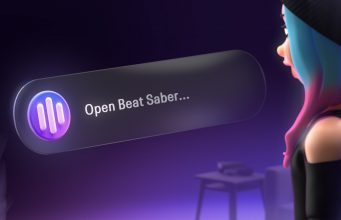
Oculus today announced that it’s rolling out a small but welcomed change to Quest’s voice commands feature: the ability to activate it with a wake phrase—”Hey Facebook.”
Quest got voice commands last year, allowing users to double-tap the Oculus button on their controller to then say phrases for quick and useful navigation, like launching apps, browsing the store, or taking a screenshot. When using the headset with controllerless hand-tracking, however, the only way to activate voice commands was to open the Quest menu, navigate to settings, and click the voice commands button—somewhat defeating the purpose of quickly navigating the headset with your voice.
Today Oculus announced it’s adding a wake phrase to Quest’s voice commands, making it easy to get the headset to listen whether you are using controllers or hand-tracking. But the company settled on a seemingly odd choice: “Hey Facebook.”
Obviously Facebook is Oculus’ parent company, but it seems a little strange to refer to the headset by the name of the social media company, especially considering its poor reputation on privacy and widely criticized move to require Facebook accounts to use Oculus headsets after promising it wouldn’t. “Hey Oculus” or “Hey Quest” seems much more intuitive, and comes with less baggage.
The move happened alongside the company also adding “Hey Facebook” as a wake phrase for its Portal smart displays, which helps explain the company’s thinking.
Facebook likely wants consistency between voice commands on any of its voice-activated devices to create a more cohesive perception of Facebook’s wider business activities which have grown well beyond a mere social media network media. The company may also be readying its own competitor to the likes of Alexa, Google Assistant, and Cortona (currently Quest voice commands are limited to navigation and fall short of ‘digital assistant’).
Practically speaking, “Hey Oculus” or “Hey Quest” is not only more intuitive, but may also be more practical… if a user has both a Portal and an a Quest headset, how will they avoid activating Portal with “Hey Facebook” while trying to talk to Quest? This seems like it would be problematic, at least until the devices have awareness of one another.
Oculus says the “Hey Facebook” wake phrase is rolling out gradually to Quest 2 headsets as an experimental feature; in due time the company plans to deploy it to the original Quest as well, and eventually move it from an experimental feature to a default option. The company maintains that the wake phrase will be an opt-in feature, and that Quest doesn’t listen for “Hey Facebook” when it’s asleep or powered off.
The post You Can Now Activate Quest Voice Commands Hands-free, But You’ll Have to Say “Hey Facebook” appeared first on Road to VR.
Ream more: https://www.roadtovr.com/oculus-quest-voice-commands-wake-phrase-hey-facebook/
‘Superhot VR’ on Quest Surpasses 1 Million Units Sold, Quest 2 Sales Outperform All Platforms
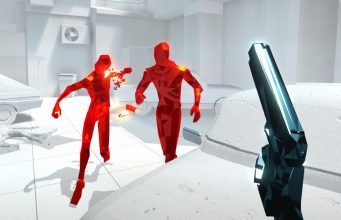
Superhot VR (2016) has long been held up as one of the ‘must-have’ VR games. Now the studio announced it’s just tipped the one million mark for units sold on the Oculus Quest platform.
Superhot VR is a virtual reality success story if we’ve ever heard one. Taking the same mechanics from the studio’s viral hit Superhot (2016), its VR counterpart offers up an addictive mix of cinematic slow-motion action scenes as you physically bust up the hordes of oncoming red crystalline enemies.
Superhot Team announced the news in blogpost, celebrating the PC game’s fifth year birthday. There’s no word on exactly how much of this is owed to sales on Quest 2, Facebook’s recently launched follow-up to the standalone headset, but we have a rough idea.
The graph below (provided by Superhot Team) represents all Superhot franchise games sold to date. In the purple you can see Superhot VR, which saw a significant bump in sales with the release of Quest in May 2019—nearly twice as much than the flatscreen game its its viral heyday in 2016.

That even larger spike in sales in late 2020 was on Christmas Day, which the studio notes was the day when more copies of Superhot VR were sold than ever before. This is undoubtedly a result of new Oculus Quest 2 owners buying the game en masse for their first VR experience.
What’s more, at $25 (currently on sale for 30% off), that puts gross revenue somewhere topping out at $25 million. There have been regulars sales and bundles, so that’s only a conservative estimate on the high side though, but it’s a number that makes VR development sound pretty attractive.
It’s no secret however that Quest 2 has accelerated sales in many games on the Oculus Store. Facebook announced recently that the plucky $300 standalone helped generate over $1 million in sales for over 60 Quest apps, making for about a third of all apps on the official store. Meanwhile, Quest 2 has leaped to the second most-used VR headset on Steam, owed to its ability to use Oculus Link and a VR-ready PC.
The post ‘Superhot VR’ on Quest Surpasses 1 Million Units Sold, Quest 2 Sales Outperform All Platforms appeared first on Road to VR.
Ream more: https://www.roadtovr.com/superhot-vr-quest-1-million/
Hyper Dash Is OUT Today! And It's AWESOME (+ Giveaway!)
Hyper Dash VR is out today! Here's our early look at the multiplayer gameplay on Oculus Quest 2 with native bHaptics support. Watch for an overview of the gameplay mechanics, exciting multiplayer gameplay & our thoughts. ► Our VR equipment kit & tips here → https://www.amazon.com/shop/caschary (affiliate link) ► Subscribe here → https://goo.gl/bSJ6L8 Hyper Dash by Triangle Factory is a 5 vs 5 team-based multiplayer shooter. It’s a fast-paced, competitive game with multiple game modes. I’ll talk more about these modes in a bit. But what makes this game stand out is the use of walking, dashing, sprinting, and rail grinding. Thanks to @BMF & @GAMERTAG VR for joining us today! ----------------------------------------------------------------------------------- LINKS ► Get Hyper Dash on Oculus → https://www.oculus.com/experiences/quest/3070239359662935/?locale=en_US ► Get Hyper Dash on Steam → https://store.steampowered.com/app/1386890/Hyper_Dash/ ► More info on the bHaptics Suits → https://www.bhaptics.com/ ► Join our Discord here → https://discord.gg/YH52W2k ► Oculus Quest 2 giveaway by VAL: https://gleam.io/3vQY1/one-arena-quest-2-contest ► Get an Oculus Quest 2 (US) → http://bit.ly/quest2-casvr ► Get an Oculus Quest 2 (NL - Coolblue) → https://cb.prf.hn/l/784dkp8 ► Get on Amazon → https://amzn.to/2RSxaDi May contain affiliate links that earn us a small referral fee from qualifying purchases at no extra cost to you. ----------------------------------------------------------------------------------- TIMESTAMPS 00:00 Intro (Watch the whole video for support) 01:16 Hyper Dash Summary & Release Details 02:08 Gameplay Mechanics & Modes Tour 05:42 Multiplayer Gameplay: Payload 14:01 Hyper Dash Cosmetics & VR Settings 14:56 Our Impressions ----------------------------------------------------------------------------------- SUPPORT THE CONTENT (and become our VR Champion) ► Become our Patron → http://bit.ly/PatreonCasandChary ► Become a Sponsor on YouTube → http://bit.ly/JoinCasandChary ► Buy our VR Merch → http://bit.ly/casandchary-merch VR DISCOUNT CODES & AFFILIATE LINKS ► ► https://casandchary.com/discount-codes-affiliate-links/ ----------------------------------------------------------------------------------- OUR GEAR Our VR Equipment & Tips → https://www.amazon.com/shop/caschary (affiliate link) Our PC Specs → https://casandchary.com/vr-equipment/ MUSIC Music we use is from Epidemic Sounds → http://bit.ly/CCEpidemicSound ----------------------------------------------------------------------------------- GET LATEST UPDATES Twitter → https://twitter.com/CasandChary Facebook → https://www.facebook.com/casandchary/ Instagram → https://www.instagram.com/casandchary/ Join our Discord → https://discord.gg/YH52W2k ----------------------------------------------------------------------------------- A SPECIAL THANKS to these Patreon Champs 🛡️ for their support: 😘 BaxornVR, Wintceas, Studioform VR, Barr'd4Life, Andy, Albert, Ben P., Steve Dunlap, Thomas M. Rice, Andy Fidel, VR Balance, Nathan S., Adriaan K. ----------------------------------------------------------------------------------- DISCLAIMER This video was sponsored by VAL & bHaptics. Per our guidelines, no review direction was received. Our opinions are our own. Links in this description may contain affiliate links. We may earn a small referral fee from qualifying purchases that helps supports the channel. However, it doesn't cost you more. #hyperdash #oculusquest2 #casandchary VR on! - Cas and Chary VR
Wednesday, February 24, 2021
SteamVR Update Brings Full Support for OpenXR 1.0, A Huge Step for the Open Standard
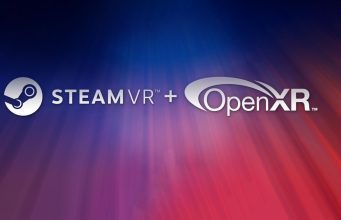
The latest update to SteamVR, version 1.16, now includes full support for OpenXR 1.0, the widely backed industry standard which aims to make cross-platform VR development easier by allowing developers to build around a single API rather than porting their apps to many different APIs for different headsets. SteamVR’s support for OpenXR 1.0 is a huge step forward for the adoption of the standard.
SteamVR is the leading platform for PC VR thanks to its wide ranging support for every major PC-compatible headset. This makes it one of the most important platforms to adopt OpenXR, which will make it easier for developers to create applications which work seamlessly across a growing number of VR headsets.
Valve says that version 1.16 of SteamVR, available today to all users, “now passes all OpenXR 1.0 conformance tests on Windows for Vulkan, OpenGL, D3D11, and D3D121.”
This means that Valve is now giving VR developers the greenlight to build and distribute OpenXR apps which will seamlessly support major headsets with less work from developers. Such apps will also be compatible with other OpenXR platforms even outside of SteamVR (for instance, a developer could theoretically distribute the same OpenXR application on Steam and Oculus PC without making any changes to the code).
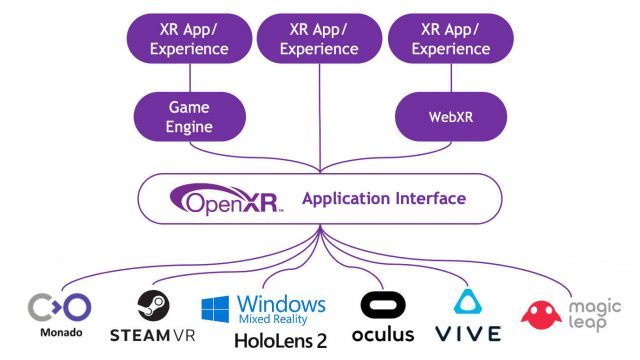
SteamVR version 1.16 also brings a handful of fother improvements, including more options for VR app rendering performance (like throttling, prediction, and motion smoothing). You can check out the full patch notes here.
OpenXR has been in the works for several years, and has garnered backing by many key players in the XR space. The 1.0 version of the standard was announced in 2019 and has been slowly but steadily finding its way into key VR platforms and game engines like Oculus Quest & Rift, Windows Mixed Reality, Unity, Unreal Engine, SteamVR, and more.
The post SteamVR Update Brings Full Support for OpenXR 1.0, A Huge Step for the Open Standard appeared first on Road to VR.
Ream more: https://www.roadtovr.com/steamvr-update-brings-full-support-openxr-1-0/
‘VRChat’ Can Now Import Free Customizable ‘Ready Player Me’ Avatars
Ready Play Me, the free avatar maker from Wolf3D, now supports exporting avatars to VRChat, making it quick and easy to get a customizable avatar into one of the most popular social VR applications.
While VRChat is host to tons of zany user-created avatar choices (or you can build your own from the ground up if you’re technically skilled), sometimes you want to embody an avatar that feels personal to you. But how do you get one?
Ready Player Me is a free avatar maker which now supports VRChat. With its web-based tool, you can create a custom avatar in a matter of minutes, then import it directly into VRChat with the push of a button (at the time of writing the site warns it may take 10–15 minutes for the avatar to appear in VRChat due to demand).
To make your own Ready Player Me avatar for VRChat, just use the web-based avatar creator here (you can start by taking a selfie, or skip that step and go directly to customization). Once you’re happy with your avatar, click the ‘Done’ button at the top right, then click ‘Import to VRChat’ in the pop-up menu.
Ready Player Me avatars are supported by a growing list of VR applications like Mozilla Hubs, LIV, MeetinVR, and more, now including VRChat. Avatars can also be downloaded in the .fbx format.
The company behind the tool, Wolf3D, says its avatars are compatible with VRChat’s latest avatar system called Avatars 3.0 (AV3), which allows players to use the game’s built-in expression system for emotes and other avatar actions.
While it’s great to have a simple tool for avatar creation, it’s still clearly early days for Ready Player Me, which currently offers customization of hair, facial hair, and outfits, but lacks key options like like facial structure, height, and weight.
![]() With the company raising $1.3 million last year, we expect to see the options fleshed out in due time. Though we don’t expect it to be free indefinitely—the obvious future for a tool like Ready Player Me is to offer a basic set of free customization options, while keeping a large wardrobe of premium styles which users can buy with real money.
With the company raising $1.3 million last year, we expect to see the options fleshed out in due time. Though we don’t expect it to be free indefinitely—the obvious future for a tool like Ready Player Me is to offer a basic set of free customization options, while keeping a large wardrobe of premium styles which users can buy with real money.
The post ‘VRChat’ Can Now Import Free Customizable ‘Ready Player Me’ Avatars appeared first on Road to VR.
Ream more: https://www.roadtovr.com/make-vrchat-avatar-ready-player-me/
Microsoft to Talk About the Future of XR in Ignite 2021 Keynote Hosted in ‘AltspaceVR’

Microsoft is looking to make good use of its social VR platform AltspaceVR next week as it hosts its first Ignite keynote in virtual reality.
Alex Kipman, technical fellow at Microsoft’s AI and Mixed Reality team, announced that the virtual event will be taking place in the company’s social VR platform for all to join, either in-headset or via livestream video.
Kipman, who was one of the fundamental drivers behind the creation of HoloLens, says the keynote is slated to be an experience that will offer “more immersion than you’ve ever seen before.”
Register here for @Microsoft‘s virtual event (Mar 2-4):https://t.co/8s8s1PidNY pic.twitter.com/1uVy3bb3xB
— Alex Kipman (@akipman) February 24, 2021
AltspaceVR has changed quite a bit since the first days of consumer VR, and even more so after Microsoft acquired the ailing social platform in 2017. Since then, AltspaceVR has been refocused as an event platform that hosts user-created meetups of all sorts. AltspaceVR supports SteamVR headsets, Oculus Rift, and Oculus Quest.
We’re not sure what to expect from the keynote, but it’s certainly making good use of VR as a way to bypass the whole social distancing phenomenon which has disrupted all manner of yearly expo and conference. Whatever the case, Microsoft is using the all-digital event to talk about new products, so it may have something VR/AR up its sleeves.
Although you can sign up for all other talks by registering, the VR keynote hasn’t been officially posted yet, however you should find it on the AltspaceVR event page closer to the kickoff of the event, which starts on March 2nd at 8AM PT (local time here). Make sure to check out the full list of events and keynotes for the three-day event here, and signup for special digital access.
Besides the XR-centric keynote, another highlight of Ignite 2021 is invariably a talk from Simon Skaria, director of HoloLens and computer vision at Microsoft, which promises to include info on the company’s vision for the future of mixed reality. We’ll be following along throughout Ignite, so make sure to check back then.
The post Microsoft to Talk About the Future of XR in Ignite 2021 Keynote Hosted in ‘AltspaceVR’ appeared first on Road to VR.
Ream more: https://www.roadtovr.com/microsoft-ignite-2021-altspacevr/
One of Quest’s Best-rated Experiences, ‘ALTDEUS: Beyond Chronos’ Launches on SteamVR

Sci-fi anime VR visual novel experience ALTDEUS: Beyond Chronos launched on Oculus Quest in December and quickly rose to become one of the best rated titles on the headset. Now the app has launched on SteamVR for PC VR users to enjoy.
As an anime experience featuring “robot battles, pop music, and emotion,” Altdeus might not be everyone’s cup of tea, but those looking for this kind of experience have given the game top marks on Oculus Quest. Currently the game ranks as the 2nd best-rated paid app on Quest, with an average rating of 4.9 out of 5 against more than 650 reviews.
Now Altdeus has launched on SteamVR, opening the door to players across the PC VR landscape. Interestingly, the experience is being sold for $30 (which is $10 cheaper than the Quest version), plus an additional launch discount of 10% (ending soon).
Altdeus promises 15–20 hours of gameplay with “one of the largest branching storylines ever in a VR game.” Here’s the trailer and premise straight from developer MyDearest Inc.
Become Chloe, a mecha pilot who will have her revenge and annihilate the Meteora once and for all. Pilot a giant mecha and make the decisions to determine humanity’s future. Explore new choices to uncover new branches of the story and discover all of ALTDEUS’ endings! Discover the truth, destroy the enemy, and enjoy the cyberspace pop concerts!
The studio also says the experience is heavily designed around player comfort and “highly recommended for people who don’t have a high tolerance against motion sickness.”
Though it takes place 300 years in the future, Altdeus is actually a sequel of TOKYO CHRONOS (2019), a previously released VR experience by the same studio. With both titles now available on Steam, the developer is selling both games in a bundle with a 24% discount.
Altdeus: Beyond Chronos is also available on Oculus PC and due to launch on PSVR on April 15th.
The post One of Quest’s Best-rated Experiences, ‘ALTDEUS: Beyond Chronos’ Launches on SteamVR appeared first on Road to VR.
Ream more: https://www.roadtovr.com/altdeus-beyond-chronos-steamvr-launch-pc-vr/
Hands-on: Impressive PS5 DualSense Haptics Bodes Well for Next-gen PSVR Controllers
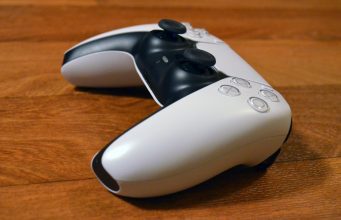
The launch of PlayStation 5 brought backwards compatible support for PSVR, but with Sony confirming a new PSVR headset in the works we’d be lying if we said we weren’t most excited by what’s around the corner. A new VR headset is alluring in itself, but even more so given Sony’s confirmation that “key features” from its impressive PS5 DualSense controllers will be part of the next-gen PSVR controllers.
Update (February 24th, 2021): Sony today confirmed work on a next-gen PSVR headset, including revamped controllers which will contain “some of the key features found in the DualSense wireless controller.” With that in mind, we’re highlighting our previous hands-on which explores how well suited the DualSense capabilities are to VR.
Original Article (October 27th, 2020): If you know your game console history, you’ll know that Sony coined the name ‘DualShock’ for its first haptic controllers introduced all the way back in 1997 on the original PlayStation console. With 23 years of DualShock controllers on PlayStation consoles between then and now, you’ll understand why it’s a big deal for Sony to call its PS5 controller by a new name: DualSense.
DualSense isn’t just a name change… it really is a big jump in controller technology from its predecessors. Beyond being arguably the company’s most ergonomic controller yet, the DualSense controller is packed with impressive haptics and motion tracking—the same tech we’d love to see in a future VR controller.
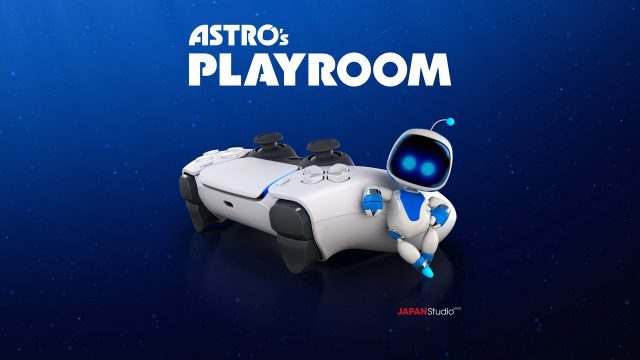
I got to take the controller for a lengthy spin in the ‘Cooling Springs’ level of Astro’s Playroom, a non-VR spin-off from the same studio behind the PSVR masterpiece Astro Bot Rescue Mission (2018). The game was designed to show off everything the controller can do.
More Than Rumble
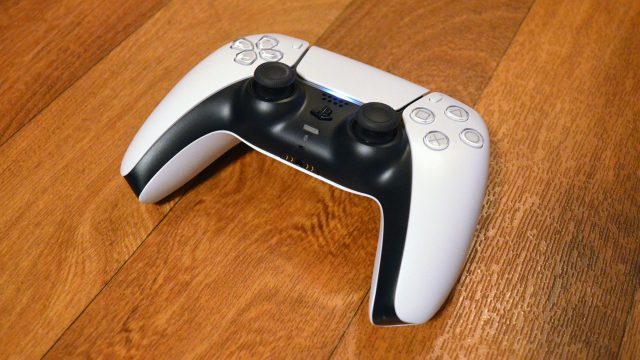
Let’s talk first about rumble haptics. While the prior DualShock 4 controller was no slouch, the DualSense controller really is next-level. Rather than old-school ERM (eccentric rotating mass) rumble motors, the controller features a pair of powerful LRAs (linear resonant actuators) which are capable of a much wider range of haptic sensations or ‘haptic effects’ like buzzing, rumbling, thumping, pulsing and everything in between.
And the LRAs pack a punch. There’s so much power behind them that at times it can feel like the controller is actually filled with something that’s jumbling around within its volume… and this is where I apologize for attempting the impossible task of trying to convey haptic effects through text.

The bottom line here is that the LRA-based haptics are capable of delivering a far wider range of haptic effects compared to the ERM of yore. You can think of LRA as increasing the ‘haptic resolution’ the controller is capable of; the difference and complexity of the effects is instantly noticeable with the DualSense controller.
Augmenting the LRA is a small speaker on the controller which not only adds an extra channel of ‘close’ audio to the overall feedback, but the speaker’s high frequency micro vibrations actually contribute further still to some of the haptic sensations. In Astro’s Playroom this was used for things happening directly to the character, like the ‘tink tink tink’ sound of their little feet walking on metal or glass, or the sound of rustling through foliage.
Triggers That Communicate
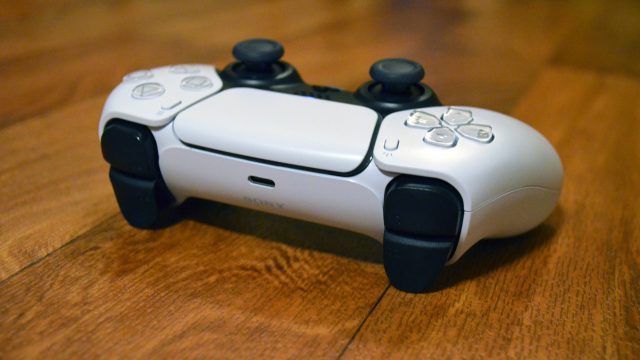
Then there’s the adaptive triggers which offer dynamically-controlled spring strength. While the trigger normally feels no different than your typical controller, the force required to pull the trigger can be adjusted on the fly, ranging from the default strength to something much harder—an effect which makes it feel like the game is ‘resisting’ your intentions. In Astro’s Playroom this is used, for example, to give a sensation of ‘crushing’ an object.
And the triggers can do more complex effects too. Rather than simply being harder to pull, it’s possible for them to be harder to pull up to a point, and then suddenly ‘let go’ after that point. That can make it feel like you’re ‘struggling’ through something until it gives way. The reverse is also possible, where the trigger can feel easy to pull until a certain point and then become harder to pull, as if you’re ‘run into’ something along the way.

Being able to change the trigger pull force on the fly allows the game to communicate far more information back to the player through one of the most important buttons on the controller. Opening up pathways for communicating additional information to the player is what haptics is all about, and it adds another layer of immersion.
For instance, in another game you could imagine the trigger suddenly becoming very hard to pull once your gun is out of ammo—to intuitively indicate that the current trigger pull is ‘invalid’ without needing to flash text on the screen.
It should be pointed out that, while the adaptive triggers are quite impressive, they don’t support what you’d call ‘force feedback’ (which would be where the triggers don’t just resist your pull to a greater or lesser effect, but can actively push back against your finger).
Motion Tracking
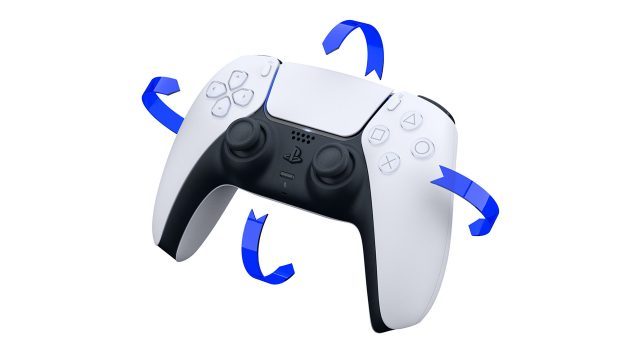
And then there’s the DualSense tracking, which has astounded me. To be clear: the tracking in the DualSense controller is only rotational (3DOF) right now, but Sony seems to have found some ultra-precise IMU because, even without any external reference point, the DualSense controller seems almost devoid of drift.
That’s counter to my experience with PSVR devices in the past. Even with external tracking from the PS4 camera, I’ve noticed plenty of drift from the headset, PS Move, and PS Aim in various games.
While playing in ‘Cooling Springs’ in Astro’s Playroom the game allowed me to ‘inspect’ an object I found by rotating my controller in space, which would then rotate the object on screen. This gave me a good chance to test out the DualSense motion tracking.
No matter how violently I tried to shake and twist the controller, the on-screen object never lost its ‘forward’ direction—even without an external camera aiding in the tracking. I even sat the controller down in a random orientation for 30 minutes, and then compared the position of the object before and after, and found hardly any change. This shows that the controller’s IMU has very little internal drift and noise.
Little known fact about VR tracking systems: the IMU does the bulk of the tracking work, even for 6DOF tracking. While an external frame of reference—like a camera for inside or outside tracking—is important for correcting drift over time, it provides comparatively infrequent updates (on the order of 60Hz) compared to the IMU (typically around 1,000Hz).
That means that a good IMU is essential to a highly accurate 6DOF tracking system. And from what I’ve seen with the DualSense controller, Sony has picked a darn good one.
– – — – –
All told, the tech Sony is showing off in its DualSense controller on PS5 is really impressive and would be a perfect fit if realized in a PSVR 2 controller, whether that be a PS Move 2 or something else. Haptics are all about increasing immersion, and it’s not hard to imagine how even the existing PS Move controller would benefit from LRA rumble, adaptive triggers, and a much better IMU for tracking—culminating in a much more immersive VR experience.
The good news is that Sony has already deemed this controller tech good enough, cheap enough, and power efficient enough to stick into its standard controller. That bodes very well for potentially seeing the tech come to a next-gen PSVR controller.
The post Hands-on: Impressive PS5 DualSense Haptics Bodes Well for Next-gen PSVR Controllers appeared first on Road to VR.
Ream more: https://www.roadtovr.com/ps5-dualsense-hands-on-haptics-tracking-psvr-controller-future/
Tuesday, February 23, 2021
Next-Gen VR Dev Kits for PS5 Shipping Soon with “completely new VR format”
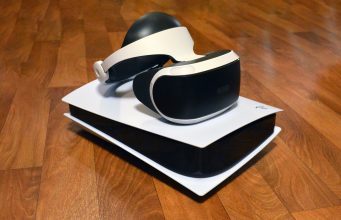
Sony today announced that its next-generation VR headset is coming—not in 2021, but it’s definitely a thing. In an interview with GQ, Sony Interactive Entertainment CEO Jim Ryan says dev kit headsets are close to landing in the hands of developers.
Ryan tells GQ in an interview that the still unnamed headset will be “a completely new VR format for PS5.”
From what we’ve learned so far, those new features will include a single-cord setup, higher resolution, larger field of view, better tracking, and more ergonomic VR controllers housing some of the same tech as DualSense.
“We think there are two themes that you’re going to see: us capturing the technological progress that has taken place since the present VR system came to market and a considerable amount of lessons learned,” Ryan says.
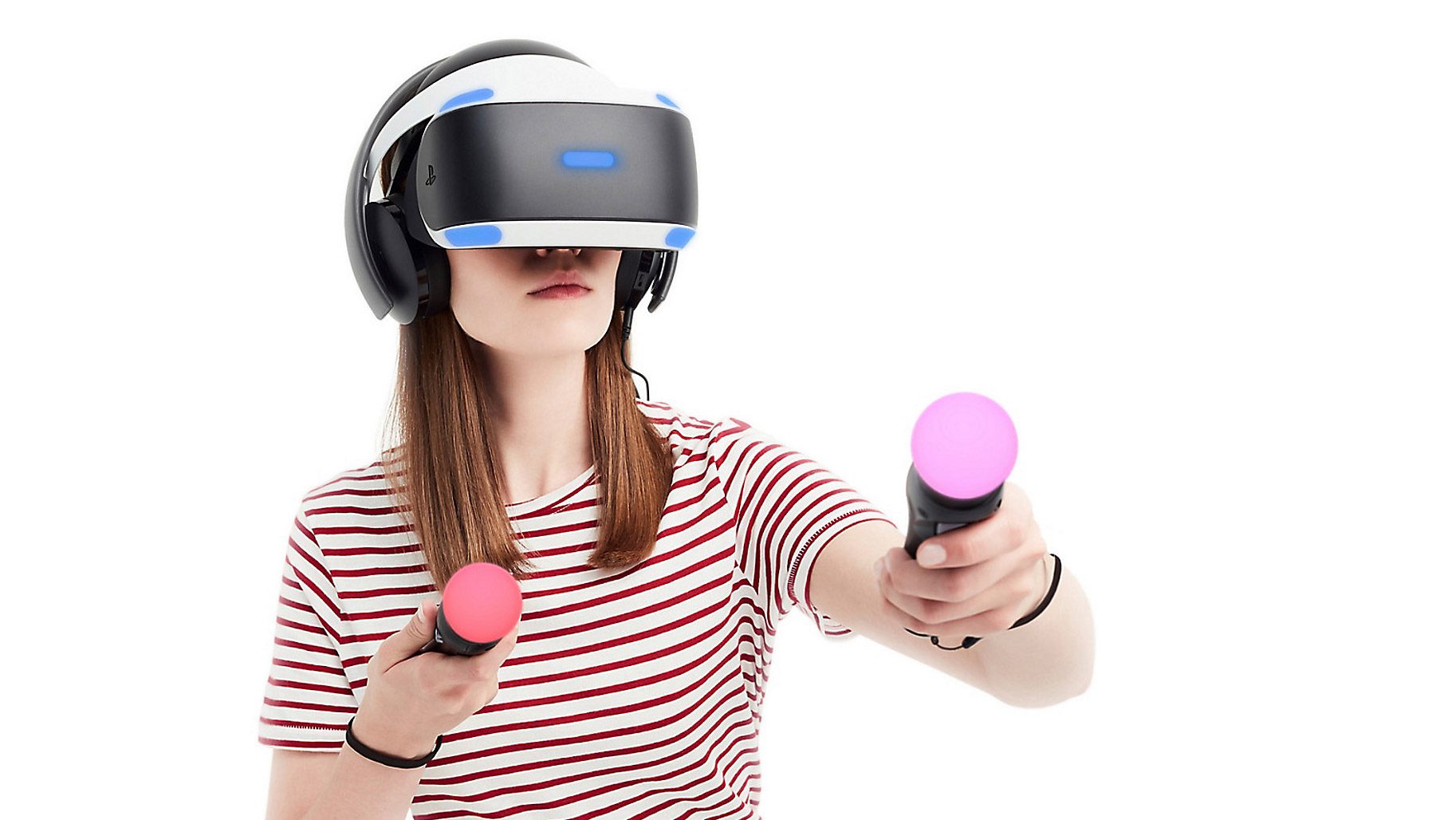
Ryan mentions that one of those lessons was reducing the entire cable setup to a single cord, saying that “many other similar learnings” are making their ways to the company’s next VR headset. Considering however that dev kits are “about to go out,” Ryan reveals, it’s likely many of the most important bits are already baked in.
Ryan reconfirms SIE’s commitment to VR, saying the continuation of its console-based VR hardware is “a very logical step to take.”
“We believe in VR and have been extremely happy with the results with the present PlayStation VR and think that we will do good business with our new VR system for PlayStation 5. More importantly, we see it as something beyond this coming iteration that really could be really big and really important. We like to innovate; we think our community likes us to innovate. I’d turn around the question and say, “Why not?” For us, it’s a very logical step to take. We’re very excited by it and we think that people who are going to make VR games for our new VR system are going to be very excited too.”
Ryan was mum on two important bits however. There’s no official naming scheme for the headset yet, and the company isn’t announcing anything specific about developer support, or anything regarding partner studios. Still, he says SIE will “launch our new VR system with appropriate software support.”
As one of the oldest, lowest resolution VR headsets still available to consumers, it’s exciting to see Sony reconfirm their commitment (and financial backing) to the medium. Despite aging hardware specs, there are a host of awesome first and third-party games for PSVR such as Astro Bot: Rescue Mission, Tetris Effect, Blood & Truth, Moss, Beat Saber, and Resident Evil 7 biohazard. If Sony is putting their full weight behind its next-gen VR headset, we’re hopefully looking forward to a new class of VR games that take advantage of all that PS5 has to offer.
The post Next-Gen VR Dev Kits for PS5 Shipping Soon with “completely new VR format” appeared first on Road to VR.
Ream more: https://www.roadtovr.com/sony-release-next-gen-vr-dev-kits-ps5-soon-featuring-completely-new-vr-format/
Sony Confirms Next-Gen PSVR is Coming, New Controllers to Feature DualSense Tech

Sony has been awfully quiet about the follow-up to its PSVR headset, which was initially released back in October 2016. Today the company publicly announced it is indeed working on its next-generation VR headset for PS5 consoles. There’s only a few scraps of info for now, but there should be plenty of time to tease out the specifics. In short: it’s looking to be a vastly improved piece of kit.
Hideaki Nishino, Sony’s senior VP of Platform Planning & Management, announced in a blogpost that the next-gen VR headset for PS5 is coming. Exactly when, we aren’t sure, but Nishino says we shouldn’t expect it in 2021.
Sony’s next-gen VR headset will enable “dramatic leaps in performance and interactivity,” Nishino says, and that players will feel “an even greater sense of presence and become even more immersed in their game worlds once they put on the new headset.”
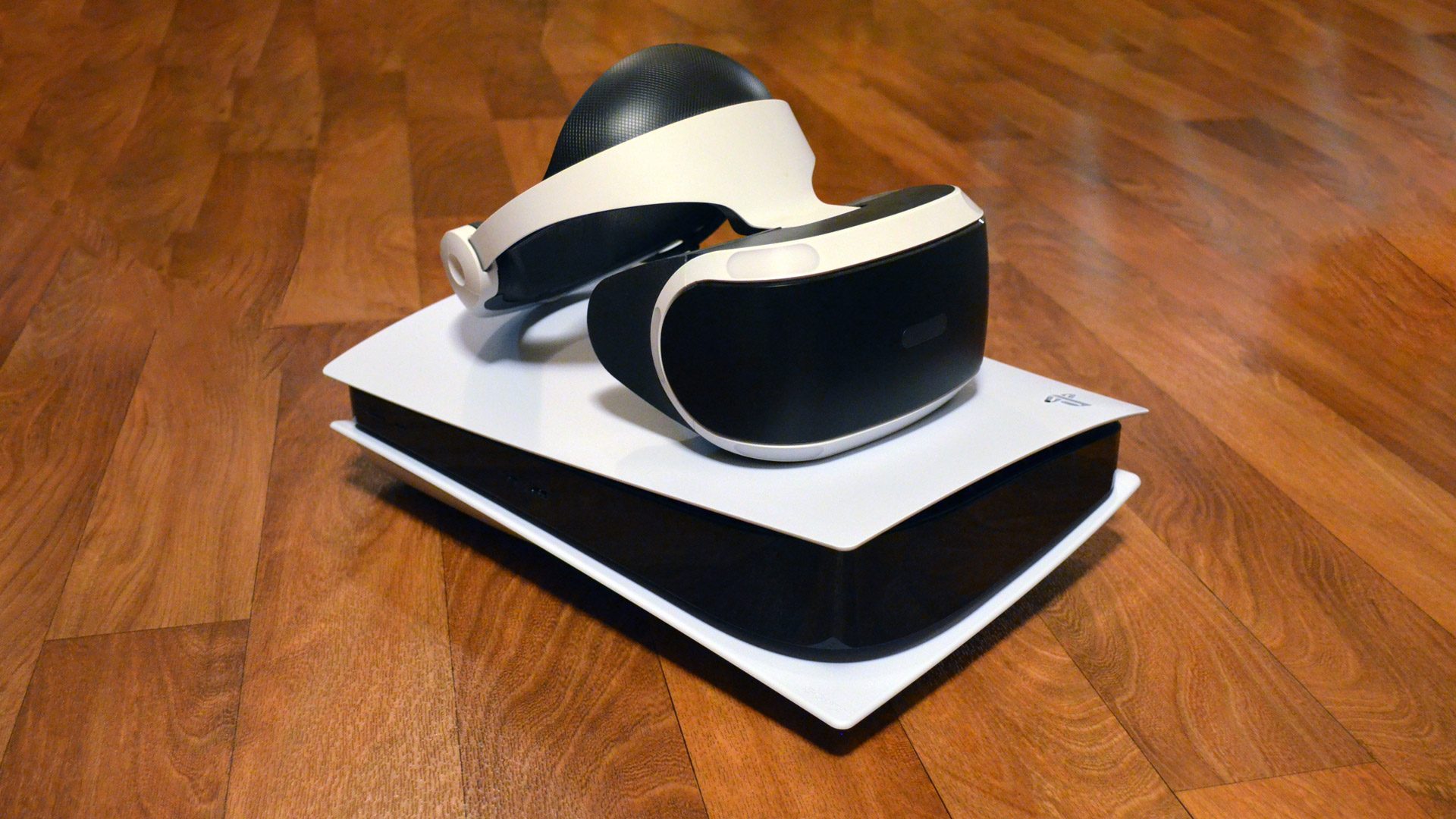
The company reveals it’s enhancing everything “from resolution and field of view to tracking and input.” The headset, which is still unnamed, is slated to connect to PS5 with a single cord to simplify setup and improve ease-of-use.
And if you were wondering whether Sony is finally kicking PS Move to the curb, you’ll be happily surprised to hear that the company is releasing an entirely new VR controller. It’s said to include “some of the key features found in the DualSense wireless controller,” which is also focusing on ergonomics.
DualSense has some genuinely impressive haptics, which includes adaptive triggers for more immersive feedback, and it’s exactly the sort of leap in ergonomics and haptics we wanted to see in the hands of PSVR players.
We’re still looking around for fresh info on Sony’s next VR headset. We’ll update this article as new information comes in.
The post Sony Confirms Next-Gen PSVR is Coming, New Controllers to Feature DualSense Tech appeared first on Road to VR.
Ream more: https://www.roadtovr.com/sony-confirms-next-gen-psvr-coming-new-controllers-feature-dualsense-tech/
nDreams Announces $2M Fund for VR Devs Looking for a Publisher

If you’re developing a VR game, you may be able to strike a deal with one of the most senior VR studios out there. nDreams, a developer and publisher of VR games, announced the creation of a $2 million fund which it will use to co-fund and publish externally developed VR titles.
The studio says it’s looking for VR games that “embrace the immersive, high-agency potential of the medium,” which essentially means only true ‘VR natives’ need apply.
nDreams says that in addition to providing development funds, the studio is also capable of offering publishing support, market knowledge, data insights, first-party relationships, and game marketing & sales experience. Additionally, nDreams says it can provide QA, localization, production, and technical/design consultation.
nDreams has created many titles across all VR headset hardware since it started developing VR games back in 2013, including Phantom: Covert Ops, Shooty Fruity, The Assembly, and VR meditation app Perfect. As one of the most senior VR studios out there, nDream’s publishing team also boasts 20 years of collective experience in VR, having additionally worked for AAA publishers including Ubisoft, Capcom, SEGA and WB Games.
“We know how difficult it can be to get a VR game to market successfully” said David Corless, VP of Publishing. “We want to share our knowledge with other studios to help them make the best game they can and to give those titles every chance of becoming a huge success, whether that be through development funding or solely publishing support.”
Developers interested in partnering with nDreams can get in touch via publishing@ndreams.com for more information.
The post nDreams Announces $2M Fund for VR Devs Looking for a Publisher appeared first on Road to VR.
Ream more: https://www.roadtovr.com/ndreams-2-m-fund-vr-developers/
Qualcomm Announces Tethered AR ‘Smart Viewer’ Reference Design with Onboard Co-processing
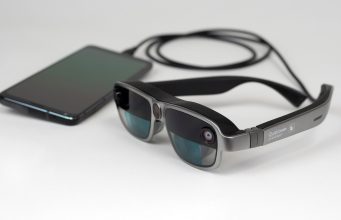
Qualcomm, maker of chips and technologies for mobile devices, today announced a reference design for a tethered AR headset which is tethered to a phone or PC but also contains its own chips to handle some onboard processing. The company calls the split-processing approach an AR ‘smart viewer’ headset.
Qualcomm, which makes the chips in many popular smartphones, has also been aggressively pursuing the growing XR market. The company offers two chips specifically intended for AR and VR headsets, Snapdragon XR1 & XR2, which are found in major devices like Quest 2 and HoloLens 2.
Part of Qualcomm’s efforts involve creating headset ‘reference designs’, which act as blueprints (built around the company’s chips, naturally) that other companies can use as a starting point to bring their own headset to market.
Qualcomm’s latest reference design is a tethered AR headset which the company calls an ‘AR smart viewer.’ What differentiates an AR smart viewer from a basic tethered AR viewer is the inclusion of onboard processing which helps to offload some of the work from the tethered device onto the headset itself.
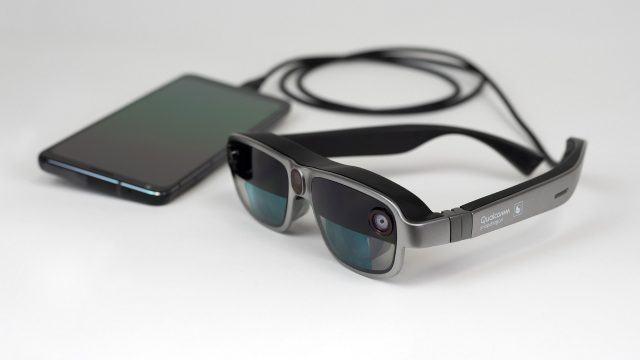
Basic tethered AR viewers send all of their sensor data to the tethered host device (usually a smartphone) which handles all of the sensor processing while also rendering the AR environment and application. For devices not designed for sustained workloads, that can push a smartphone to its limits in both power and cooling capabilities.
AR smart viewers, Qualcomm contends, include their own onboard processor (Snapdragon XR1 in this case) which can handle some of the sensor processing and display tasks, ultimately reducing the power consumption of the tethered device by some 30%. The only downside, it seems, is greater expense due to the added processing hardware.
Though companies that adopt Qualcomm’s reference designs may further customize their product, the reference designs themselves offer a fairly clear picture of what kind of devices we’re likely to see in the next year or two.
For the AR smart viewer reference design, Qualcomm is offering the following specs:
- Snapdragon XR1 processor (additionally tethered to a host device)
- Micro OLED display from BOE (1,920 × 1,080 @ 90Hz)
- 45 degree field of view
- Dual monochrome cameras for 6DOF tracking (1,280 × 800, 150 degree FOV)
- RGB camera for photo/video (8MP, 120 degree FOV)
Qualcomm also says it has created readymade software which will allow the AR smart viewer to run standard Android apps in floating windows, in addition to immersive AR applications.
The company says AR smart viewer headsets can alternatively be tethered Windows PCs for more flexibility, including the ability to run standard Windows applications on virtual monitors.
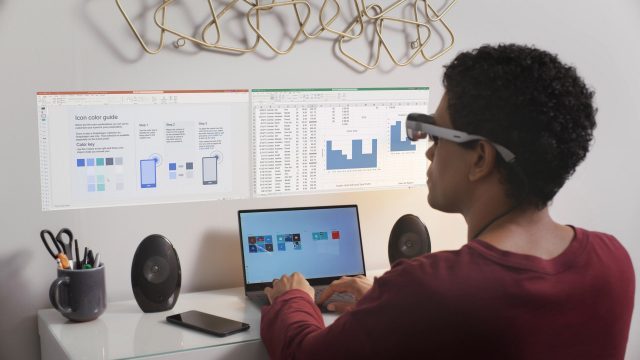
Although Microsoft has its own ambitions with Windows Mixed Reality on both PC VR and standalone with HoloLens, the company seems open to Qualcomm’s efforts to include PCs as host devices for AR smart viewers.
“The AR smart viewer category is a great vehicle to deliver immersive experiences as accessories to mobile devices, Windows PCs or other host-compute devices,” Microsoft shared through Qualcomm’s press release. “We look forward to working with Qualcomm Technologies to bring [Microsoft AR] services towards this ever-expanding ecosystem of Snapdragon-based Mixed-Reality end-points.”
Further into the future, Qualcomm hopes that AR smart viewers will eventually break free of their tether and focus instead on a wireless connection to the host device.
The post Qualcomm Announces Tethered AR ‘Smart Viewer’ Reference Design with Onboard Co-processing appeared first on Road to VR.
Ream more: https://www.roadtovr.com/qualcomm-ar-smart-viewer-headset-announcement/
THIS Is What AR Glasses Will Be Like In 2021 (Qualcomm XR1 AR)
The Qualcomm XR1 AR Glasses will give us a glimpse of what future AR glasses will be like, not in a few years but THIS year. In 2021. So let’s talk about that and also let me update you about the current state of AR glasses and what’s coming out in the coming months. ► Our VR equipment kit & tips here → https://www.amazon.com/shop/caschary (affiliate link) ► Subscribe here → https://goo.gl/bSJ6L8 ----------------------------------------------------------------------------------- LINKS ► More info on Qualcomm's XR1 platform → https://www.qualcomm.com/products/snapdragon-xr1-platform May contain affiliate links that earn us a small referral fee from qualifying purchases at no extra cost to you. ----------------------------------------------------------------------------------- TIMESTAMPS 00:00 Intro (Watch full video for support!) 02:37 Qualcomm Snapdragon XR1 AR Specs & Overview 06:08 What’s Coming This Year? 02:53 Outro ----------------------------------------------------------------------------------- SUPPORT THE CONTENT (and become our VR Champion) ► Become our Patron → http://bit.ly/PatreonCasandChary ► Become a Sponsor on YouTube → http://bit.ly/JoinCasandChary ► Buy our VR Merch → http://bit.ly/casandchary-merch VR DISCOUNT CODES & AFFILIATE LINKS ► ► https://casandchary.com/discount-codes-affiliate-links/ ----------------------------------------------------------------------------------- OUR GEAR Our VR Equipment & Tips → https://www.amazon.com/shop/caschary (affiliate link) Our PC Specs → https://casandchary.com/vr-equipment/ MUSIC Music we use is from Epidemic Sounds → http://bit.ly/CCEpidemicSound ----------------------------------------------------------------------------------- GET LATEST UPDATES Twitter → https://twitter.com/CasandChary Facebook → https://www.facebook.com/casandchary/ Instagram → https://www.instagram.com/casandchary/ Join our Discord → https://discord.gg/YH52W2k ----------------------------------------------------------------------------------- A SPECIAL THANKS to these Patreon Champs 🛡️ for their support: 😘 BaxornVR, Wintceas, Studioform VR, Barr'd4Life, Andy, Albert, Ben P., Steve Dunlap, Thomas M. Rice, Andy Fidel, VR Balance, Nathan S., Adriaan K. ----------------------------------------------------------------------------------- DISCLAIMER This video was not sponsored. Links in this description may contain affiliate links. We may earn a small referral fee from qualifying purchases that helps supports the channel. However, it doesn't cost you more. #qualcomm #arglasses #casandchary VR on! - Cas and Chary VR
Monday, February 22, 2021
Veteran Indie VR Dev Revives ‘CRASHLAND’ for Quest, Launching Thursday

If you know your VR history you might recall CRASHLAND, an early VR prototype where players would defend themselves after crash landing on a hostile planet with little more than a radar scanner and a weapon. After the project went dormant for years as the developer focused on Ocean Rift (2016), today we learn that Crashland is about to blast onto Quest after being revived and revamped.
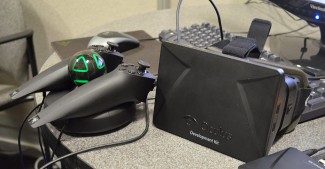
Well before the announcement of the HTC Vive or Rift CV1 and their VR motion controllers, pioneering VR developers were cobbling together Oculus Rift development kits with third-party motion controllers like the Razer Hydra to experiment with games built around motion input rather than a gamepad.
One of those early projects, developed by procedural animation aficionado Llŷr ap Cenydd, was Crashland. Initially revealed all the way back in 2013, the game had players facing off against waves of terrifying spiders that reacted in beautifully grotesque ways as they were dispatched with bullets and explosives. While Cenydd had scoped out some big plans for the project, he ultimately focused his efforts on the more tame aquatic experience, Ocean Rift, which came to almost every major VR platform over the last years.
But now, nearly eight years later, Crashland is back and looking better than ever.
The new Crashland, due to launch on Quest this Thursday for $20, maintains the same basic premise of crash landing on a hostile planet and defending yourself from waves of aliens. Aside from a full revamp of the visuals, the game’s structure has been fleshed out and includes a wide range of enemies (built around Cenydd’s signature procedural animation approach). Here’s the pitch:
The premise of Crashland is pretty simple: survive in gladiatorial combat until rescue. The full game has 24 missions, over 50 creature varieties, and 14 weapon modes. Missions are a short but very intense 5–10 minutes. It is mostly an action game but does transition in and out of horror. Each mission has a theme centered around a new creature; for example fighting giant hellworms in a sand storm, prehistoric terror birds in the forest, blood sucking spiders in the dark etc. As you play you gain XP, level up and unlock perks, including abilities like teleport punch, auto turrets, slow motion etc.
The gameplay loop is based around four mechanics: smart pistol, boomstick, scanner and teleporter. Creatures, scenarios and perks are all designed around these. For example there are creatures that jam or spam the motion scanner, drain or disable the teleporter, are drawn to or afraid of explosives etc. These are all mixed together so there’s a lot of emergent gameplay in the chaos.
When we played the Crashland prototype so many years ago, one of the major draws was how frighteningly organic the movements and deaths of the aliens were, and the tension of having a radar scanner which would beep with quickening pace as enemies approached. Cenydd says the full version of the game has amped up those elements yet further.
“One of my main focuses has been graphics and spectacle—I’m leaning heavily into my expertise in procedural animation for alien movement and the deaths in particular—the way the aliens have momentum, judder, kick and writhe adds a lot to how the combat feels. It’s a continuation of the [procedural animation systems] I did for Ocean Rift,” he tells Road to VR. “There’s also a huge variety of alien creatures—giant worms, spiders, electric slugs, ticks, dinos, scorpions, cephalopods etc. […] I hope people will get a kick out of the creatures; each mission introduces one or two completely new ones all the way through to the last mission.”
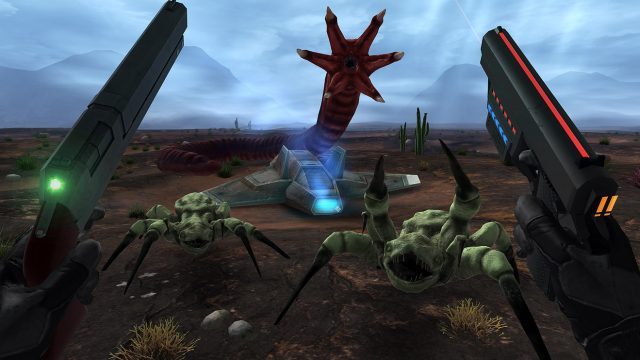
In terms of structure, the game will have a simple arcade format with menus to select levels and modes, with level completion and experience unlocking new missions and weapon abilities. Leaderboards will be included for those who want to compete for the high score. The game is single-player and Cenydd says there’s no plans for co-op at present.
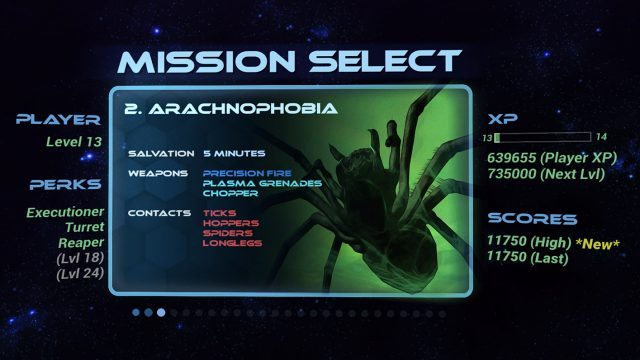
If you’re looking for a deep-dive, you can check out a 20 minute walkthrough straight from the developer:
Cenydd says he’s been building the new version of Crashland since 2019 as a side-project alongside to his day job as a professor of Computer Science at Bangor University in the UK. While the game will launch on Quest first, he remains hopeful that he can “release a PC version later down the line.”
The post Veteran Indie VR Dev Revives ‘CRASHLAND’ for Quest, Launching Thursday appeared first on Road to VR.
Ream more: https://www.roadtovr.com/crashland-announcement-release-date-oculus-quest/
Lovecraftian Horror Adventure ‘The Shore’ is Getting a VR Version Soon

The Shore (2021) is a first-person horror adventure that recently launched on PC, however now developer Ares Dragonis says the game will soon get a VR version too.
Dragonis says in the game’s Steam discussion board that the VR version is slated to arrive in “a matter of 2 months,” however the studio wants to first ensure that the flatscreen game is up to snuff.
It appears the base game won’t be getting a VR update, but rather a version of The Shore with VR support will be sold as a separate title.
Dragonis says the VR version will include many events from the standard release, but will “also include extra stuff.” There’s slated to be a pre-order scheme for the VR version, something Dragonis says will be detailed in “only a few days.”
The game centers around Lovecraftian environments and creatures; you’re tasked with unraveling secrets across the two to three-hour adventure which takes you to a mysterious island in search of your lost daughter.
At the time of this writing the flatscreen game on Steam has a ‘Mixed’ user rating. This will be Dragonis’ first publicly released VR project, so we’re hoping for all the best as he and the team bring further polish to the base game before adapting it to the most immersive medium out there.
The post Lovecraftian Horror Adventure ‘The Shore’ is Getting a VR Version Soon appeared first on Road to VR.
Ream more: https://www.roadtovr.com/lovecraftian-horror-adventure-shore-getting-vr-version-soon/
Samsung’s Leaked AR Concept Videos Reveal Its Augmented Ambitions

Leaked concept video featuring two Samsung AR devices has come to light. Although just concepts and not functioning products as such, it’s clear the Korean tech giant is gearing up to compete with companies like Facebook and Apple as they inch ever closer to releasing consumer AR headsets.
Known leaker ‘WalkingCat‘ released two videos showing a pair of separate device concepts. WalkingCat was also involved in leaking photos of Oculus Quest 2 before it was launched, and Lenovo’s latest ThinkReality AR glasses for enterprise before it was announced at CES this year.
This first device appears to be smartglasses for casual media consumption, dubbed ‘Samsung Glasses Lite’. The video (seen below) shows off what we’d expect from a pair of 3DOF-tracked smartglasses, namely the ability to view traditional flatsceen media through a virtual monitor.
One interesting idea outside the norm however is its ability to use active shading so it can not only compensate for high ambient lighting, but coopt that function to use them as ‘dumb’ sunglasses. That may mean the company wants to make them all-day wear devices.
The second device ideates a much more immersive feature set. Simply called ‘Samsung AR Glasses’, it looks to pitch the 6DOF-tracked headset for work applications such as 3D product design and collaborative in-person ‘holo calls’.
It’s important to note that these devices, as we see them in the videos, are very likely just ideas on paper at this point.
The ‘Samsung AR Glasses’ don’t appear to include any sort of optical tracking, and the glasses themselves seem to be simple plastic frames with no discernable display, be it waveguide or birdbath (waveguides can be seen on Glasses Lite, but that’s not saying much). Despite the chunky plastic frames, they’re both considerably small too.
If Samsung AR Glasses did exist as we see them in the video above, it would signify a truly magic leap in mobile processing. Being able to fit all of the required compute power, batteries, and display tech into such a small package is the dream, but currently not the reality.
So although we may not see these sorts of devices from Samsung for a while, it’s an interesting look at the state of the industry. Both Facebook and Apple are tight-lipped on their respective AR products, but you’d expect Samsung to know more about what its competitors are up to than the general public. The division between smartglasses as a ‘Lite’ option and AR glasses as a work-force-multiplier is an interesting choice which may be Big Tech’s first gambit into consumer AR; i.e. offer lower priced smartglasses with tight software integration and higher priced AR glasses for enterprise and prosumers.
The post Samsung’s Leaked AR Concept Videos Reveal Its Augmented Ambitions appeared first on Road to VR.
Ream more: https://www.roadtovr.com/leak-samsung-ar-glasses-smart-concept/
Sunday, February 21, 2021
Oculus App Sharing Explained! Buy ONCE & Play Multiplayer Tips
We tested Oculus App-Sharing on two Oculus Quest 2's! Here's an explainer & tips on this feature, like how to play multiplayer games with your household by buying it once. ► Our VR equipment kit & tips here → https://www.amazon.com/shop/caschary (affiliate link) ► Subscribe here → https://goo.gl/bSJ6L8 Oculus released a brand new feature called App Sharing & Multi-Accounts. You can also call it Family Sharing and it’s available now. The fine print in the announcement is very confusing though. So I am hoping to simplify things with this video. I tested a couple of use cases out with two Quest 2’s, and I think I’m ready to answer your most asked questions. ----------------------------------------------------------------------------------- LINKS ► Our App Sharing List → https://casandchary.com/oculus-quest-app-sharing-list/ ► Get an Oculus Quest 2 (US) → http://bit.ly/quest2-casvr ► Get an Oculus Quest 2 (NL - Coolblue) → https://cb.prf.hn/l/784dkp8 ► Get on Amazon → https://amzn.to/2RSxaDi May contain affiliate links that earn us a small referral fee from qualifying purchases at no extra cost to you. ----------------------------------------------------------------------------------- TIMESTAMPS 00:00 Intro (Watch the entire video for support!) 00:51 Simple Explanation 01:46 How To Turn App Sharing On 02:50 How To Play Multiplayer Games You Bought Once 04:00 The Current Limitations Explained 05:51 Help With This List! 06:28 Outro ----------------------------------------------------------------------------------- SUPPORT THE CONTENT (and become our VR Champion) ► Become our Patron → http://bit.ly/PatreonCasandChary ► Become a Sponsor on YouTube → http://bit.ly/JoinCasandChary ► Buy our VR Merch → http://bit.ly/casandchary-merch VR DISCOUNT CODES & AFFILIATE LINKS ► ► https://casandchary.com/discount-codes-affiliate-links/ ----------------------------------------------------------------------------------- OUR GEAR Our VR Equipment & Tips → https://www.amazon.com/shop/caschary (affiliate link) Our PC Specs → https://casandchary.com/vr-equipment/ MUSIC Music we use is from Epidemic Sounds → http://bit.ly/CCEpidemicSound ----------------------------------------------------------------------------------- GET LATEST UPDATES Twitter → https://twitter.com/CasandChary Facebook → https://www.facebook.com/casandchary/ Instagram → https://www.instagram.com/casandchary/ Join our Discord → https://discord.gg/YH52W2k ----------------------------------------------------------------------------------- A SPECIAL THANKS to these Patreon Champs 🛡️ for their support: 😘 BaxornVR, Wintceas, Studioform VR, Barr'd4Life, Andy, Albert, Ben P., Steve Dunlap, Thomas M. Rice, Andy Fidel, VR Balance, Nathan S., Adriaan K. ----------------------------------------------------------------------------------- DISCLAIMER This video was not sponsored. Links in this description may contain affiliate links. We may earn a small referral fee from qualifying purchases that helps supports the channel. However, it doesn't cost you more. #appsharing #oculusquest2 #casandchary VR on! - Cas and Chary VR
Friday, February 19, 2021
Lynx Reveals First Through-the-lens Footage of R-1 Mixed Reality Headset

French startup Lynx, which is designing a mixed reality headset (capable of both AR and VR), today revealed the first look through its novel optics.
The Lynx R-1 headset was first announced last year as a standalone headset centered around passthrough augmented reality. It’s said to include a Snapdragon XR2 processor, eye-tracking, and unique optics which the company calls a “four-fold catadioptric freeform prism.” It’s expected to launch this year, priced under $1,500.
The novel optics make the company’s first through-the-lens footage, which was revealed today, especially interesting.
While you’d be mistaken for thinking this is a transparent display (like HoloLens or Magic Leap), what you’re looking at above is actually video passthrough AR, which means cameras are feeding the outside view into the headset’s display while the virtual objects are rendered onto the scene. A photo shared by the company on Twitter showed how the footage was captured using GoPro cameras directly behind the lenses.
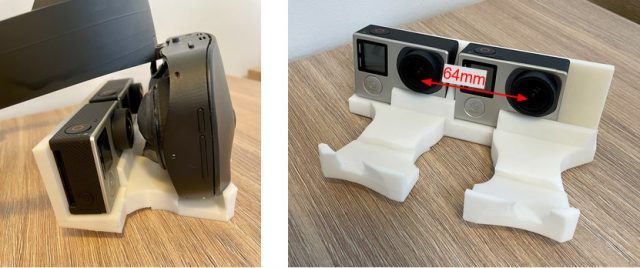
The benefit of using video passthrough to achieve AR is that the virtual objects can be completely opaque and appear more realistic. With existing transparent AR headsets, virtual objects are partially transparent because transparent displays can’t fully block incoming light.
Lynx also highlights the fact that it has designed its headset to minimize the bezel’s occlusion of the user’s real peripheral view (which can be see on the left of the video). The company says this is essential for enterprise use-cases where the user needs to be aware of their surroundings.
Beyond the impressive passthrough footage, we’re also getting our first look at how the world looks through the headset’s unique optics, which manage to hide an eye-tracking camera directly behind the lens.
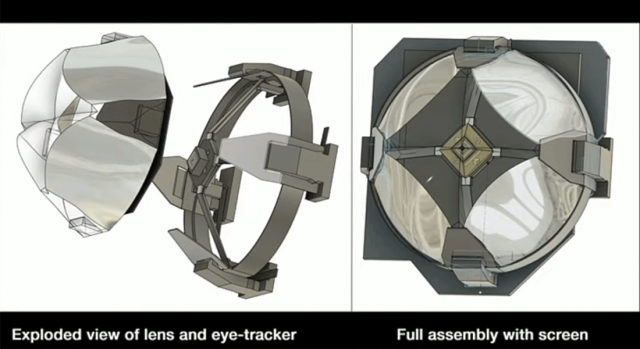
Indeed, in the footage there’s really no telling that there’s an eye-tracking camera hidden directly in the center of the lens, though it’s possible to see some artifacts from the four prisms that come together to present a singular image. Granted, it’s surprising how little distortion there appears to be at the seams. There’s no telling yet whether this will be more or less visible to the naked eye.
The post Lynx Reveals First Through-the-lens Footage of R-1 Mixed Reality Headset appeared first on Road to VR.
Ream more: https://www.roadtovr.com/lynx-reveals-first-through-the-lens-footage-of-r-1-mr-headset/
More Than 60 Quest Apps Have Generated Over $1 Million in Revenue
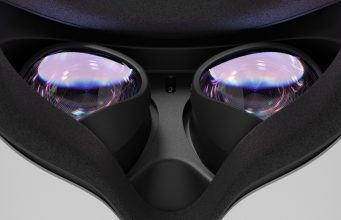
It seems the launch of Oculus Quest 2 has been a boon for both Facebook and Quest developers alike, as the company’s latest standalone VR headset has brought the number of apps earning over the $1 million milestone to over 60 games now.
Facebook announced back in September that over 35 apps on the Oculus Store for Quest had generated over $1 million, accounting for more than $150 million in app sales. That number speaks to the popularity of the original Quest, which garnered critical acclaim when it launched back in May 2019.
Then Quest 2 launched in October 2020, and the plucky $300 standalone seems to have significantly accelerated app sales.
Facebook has released a rough breakdown of how many apps have not only broken that $1 million milestone, but have also gone on to generate more than $10 million in revenue. Here’s the chart below, shared by Oculus VP of Product Mike Verdu in a company blogpost.

It’s an amazing number, but what’s more amazing is that now one in three paid apps on the Oculus Store for Quest is making over $1 million in revenue, Verdu reveals.
Some of the top-earning titles on Quest include Beat Saber, Onward, and Population: One, all of which have generated over $10 million in revenue. Verdu doesn’t offer up a more detailed breakdown, although we can bet some of the regular faces from our monthly report on the best and most rated Quest apps will appear on the list.
The post More Than 60 Quest Apps Have Generated Over $1 Million in Revenue appeared first on Road to VR.
Ream more: https://www.roadtovr.com/60-apps-oculus-quest-2-million-revenue/
At $600K, Tundra Tracker Smashes Kickstarter Goal in Less Than 24 Hours
Tundra Tracker, the SteamVR Tracking tracker in development by Tundra Labs, has well exceeded its $250,000 Kickstarter goal in less than 2...
-
DOOM 3 VR Edition launches today on PlayStation consoles, bringing the 2004 classic horror-shooter to PSVR for the first time. We haven...
-
Tundra Tracker, the SteamVR Tracking tracker in development by Tundra Labs, has well exceeded its $250,000 Kickstarter goal in less than 2...
-
InXile Entertainment, the studio behind The Mage’s Tale (2018) and The Bard’s Tale series, today announced Frostpoint VR: Proving Ground...